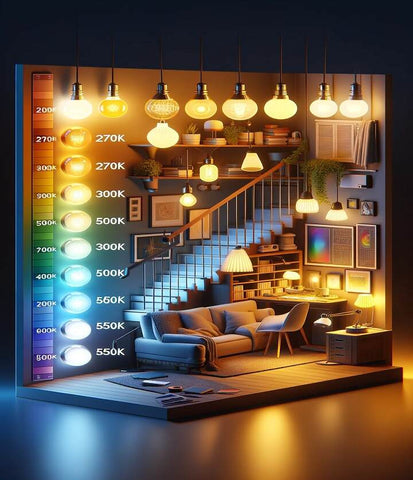
When it comes to lighting up your space, there's more to consider than just the style of your fixtures. Understanding the Kelvin color temperature of your light bulbs can significantly impact the look and feel of any room. Simply put, the higher the Kelvin rating (expressed in K), the whiter the light emitted.
Typical household fixtures have Kelvin ratings ranging from 2700K (warm incandescent) to 3500K (household fluorescent). But what does this mean for your lighting? Well, the color temperature directly influences whether your light appears warm or cool. This can set the mood, affect your alertness, and even enhance the aesthetics of your room.
For instance, in a home office, you might want a mix of color temperatures. Bright overhead lighting keeps you alert and energized, while warmer tones can create a cozy, inviting atmosphere. With a grasp of the basics, you're well on your way to mastering the art of lighting.
What is Lighting Color Temperature?

Lighting color temperature refers to how the light appears when observed directly. To put it in simple terms, it's whether the light has a warm (yellow to red) or a cool (blue to white) appearance. Under the Kelvin scale, color temperature is determined by comparing the light color produced by a theoretical black body radiator. As a quick reference, warmer color temperatures fall within the range of 2000K to 3000K, while cooler color temperatures are in the 4000K to 6000K bracket.
Importance of Lighting Color Temperature in Photography
Lighting color temperature has extensive applications across various fields, and photography is one of them. In photography, color temperature significantly influences how colors appear. Using a consistent color temperature ensures accuracy and consistency across different light sources. It impacts how realistic or attractive a photo appears. While shooting under different light sources might create discrepancies in color reproduction, photography experts can manipulate color temperatures to achieve a desired visual effect.
For instance, changing color temperature settings on your camera or editing software can accentuate the cool blue of a morning sky or the warm amber of a sunset. Whether you're clicking product images or capturing life's precious moments, understanding color temperature is imperative for creating an appealing and accurate representation of your subject.
Moreover, color temperatures can affect our mood, alertness, and even sleeping patterns. For example, cooler color temperatures, because they have a larger presence of high-energy blue light wavelengths, can enhance alertness and energy. On the flip side, warmer temperatures, rich in red-light wavelengths, promote feelings of rest and coziness.
In certain settings like your home office, you'd benefit from a mix of color temperatures. An overhead light with a cooler color temperature keeps you energized while a warmer light source on your desk can create an inviting and less strainful environment.
Understanding the Kelvin Scale
When we delve further into the subject of lighting color temperature, we can't help but stumble upon our constant companion, the Kelvin scale.
Explanation of the Kelvin Scale
In the simplest terms, the Kelvin scale is a unit of measurement for temperature, but its use isn't limited to thermodynamics. In the context of lighting, the Kelvin scale is used to define the color temperature of a light bulb. The key here is that the higher the Kelvin rating, the whiter light a bulb emits.
Relationship between Color Temperature and Kelvin Scale
You might ask, "How does color temperature relate to the Kelvin scale?" Here's the deal. In art and design, we often talk about colors in terms of warmth and coolness. Lights obey the same rules. The color temperature echoes the pattern of warm and cool colors.
However, don't be fooled by the term "temperature". In this context, it doesn't refer to the physical heat a light source emits. Instead, it's about the color characteristics of the light - whether it resembles the warm glow of a sunset, or the cool white of a midday sunlight. The intriguing part is that the higher the Kelvin rating (which denotes an increase in thermodynamic temperature), the cooler the color temperature. A higher Kelvin rating means the light emitted is closer to pure white.
Common Lighting Color Temperatures
Given that knowledge, let's delve into some examples of common color temperatures for household fixtures on the Kelvin scale:
- 2700K - This gives us a warm incandescent light.
- 3000K - This results in a warm white that you might compare to halogen lighting.
- 3500K - This leans towards the white spectrum of household fluorescent lighting.
Aside from household fixtures, TV screens also use a standard color temperature. For instance, NTSC and PAL norms require a color temperature of 6500K for a compliant TV screen to display an electrically black and white signal.
Understanding the Kelvin rating of your light sources can profoundly influence the ambience and functionality of your spaces. From creating an inviting atmosphere in a living room to maintaining alertness in an office environment, color temperature matters.
The Effects of Different Color Temperatures
Let's delve deeper into how varying Kelvin values might affect the mood, appeal, and functionality of different spaces in your home. Each color temperature range is unique and caters to certain scenarios better than others. I'll break it down into three main categories for you: warm, neutral, and cool color temperatures.
Warm Color Temperatures
Typically, Kelvin values in the range of 2700-3000K signify Warm Color Temperatures. Bulbs falling within this range emit a soft, cozy light that we often perceive as yellowish. Despite the term 'warm', this has nothing to do with physical heat; instead, it's related to color characteristics. It's interesting to note that the human eye perceives warm-colored light as close to infrared, and these light sources often emit significant infrared radiation. Warm light facilitates relaxation, making it a great choice for living rooms and bedrooms where a calm, inviting atmosphere is appreciated.
| Warm Color Characteristics |
|---|
| Type: Warm |
| Kelvin Value: 2700-3000K |
| Perceived Color: Yellow |
| Ideal For: Living rooms, Bedrooms |
Neutral Color Temperatures
Moving a little up the scale, we encounter Neutral Color Temperatures, typically ranging between 3500K to 5000K. Lights of this range enhance all existing colors in a space, providing excellent color accuracy. Consequently, they're prevalent in environments where highlighting detail is crucial, such as retail stores, galleries, and office spaces.
It's worth noting that in spite of their name, 'cool white' bulbs (4100K) fall well within the neutral range, providing balance and cleanliness for precision-focused spaces like studios and garages.
| Neutral Color Characteristics |
|---|
| Type: Neutral |
| Kelvin Value: 3500-5000K |
| Perceived Color: True White |
| Ideal For: Retail Stores, Offices, Studios |
Cool Color Temperatures
Cool color temperatures are defined by Kelvin values above 5000K. These lights emit a bluish hue and are associated with alertness and energy. Therefore, they're suitable for areas where tasks, learning, and focus are necessary, such as home offices, laundries, or commercial spaces with high visual acuity requirements.
| Cool Color Characteristics |
|---|
| Type: Cool |
| Kelvin Value: Above 5000K |
| Perceived Color: Blue |
| Ideal For: Offices, Laundry rooms |
To make the most of your indoor lighting, remember, it's not just about brightness. The color temperature plays a significant role in creating the ideal mood, enhancing productivity, or inspiring relaxation in your intended space.
How to Choose the Right Color Temperature for your Lighting
Lighting color temperature, measured in Kelvin, significantly impacts the atmosphere of a space. Knowing how to choose the right color temperature for your lighting can help you enhance the mood and functionality of a room.
Light Color Temperature Calculator
Factors to Consider when Choosing Color Temperature
When making the selection, consider carefully the purpose of a space and the type of mood you wish to bring about. For instance, a dimly lit space with a warm color temperature may be suitable for a cozy living room while a cool and brighter light can keep the home office alert and energized.
Rainbow color changing LED lighting is also an option worth considering. This innovative technology provides more flexibility, allowing you to refine the ambiance according to your mood or a specific event. Other factors influencing your decision could include:
- Existing natural light
- Color and type of decor
- Purpose of illumination
Assessing these influential factors helps in making the most appropriate selection of a bulb or tube lighting.
Matching Color Temperature to the Environment
In selecting the right color temperature, you also need to take the environment into consideration. An art gallery, for instance, may require an intricate combination of warm and cool lights to best showcase pieces of art. Similarly, a TV screen or computer monitor is often calibrated to meet industry standard color temperatures to ensure accurate color representation. For example, common monitor color temperatures fall within these ranges:
| Color Temperature (Kelvin/K) | Type |
|---|---|
| 5000K | CIE D50 |
| 5500K | CIE D55 |
| 6500K | D65 |
| 7500K | CIE D75 |
| 9300K | - |
These figures emphasize how digital displays adapt to the Kelvin scale for accurate color representation.
Using Color Temperature for Creative Effects
Color temperature doesn't just concern functionality; it can also be an avenue for creativity. By adjusting light bulb color temperatures, we can create various moods, from the calming sensation of a warm campfire to the energizing effect of cool daylight.
Full-spectrum LED lights are an excellent solution for this. With their high average CRI (Color Rendering Index) number, they bring out the true colors in a room. This color accuracy makes them better suited to an indoor environment than other lighting options, such as the average fluorescent tube.
In the end, understanding color temperature is crucial when choosing between different lighting options to create the desired atmosphere in a space.
Tips for Adjusting Lighting Color Temperature
So, you've learned that the Kelvin rating of your light bulb isn't about heat, but color. You've also discovered that it's not just a number on a box, it affects the mood and function of your space. It's a crucial factor in setting the right atmosphere. Remember, warm light gives a cozy and relaxing vibe, neutral light is best for everyday tasks and cool light promotes alertness and concentration.
Your choice should depend on the room's purpose, the existing natural light, and your decor. Don't forget that full-spectrum LED lights offer the most accurate color representation. So, next time you're choosing a light bulb, don't just grab any off the shelf. Consider its Kelvin rating and use it to your advantage. After all, understanding the basics of lighting color temperature can help you create the perfect ambience for your home.










